Do you know about our subterranean brewery bats?
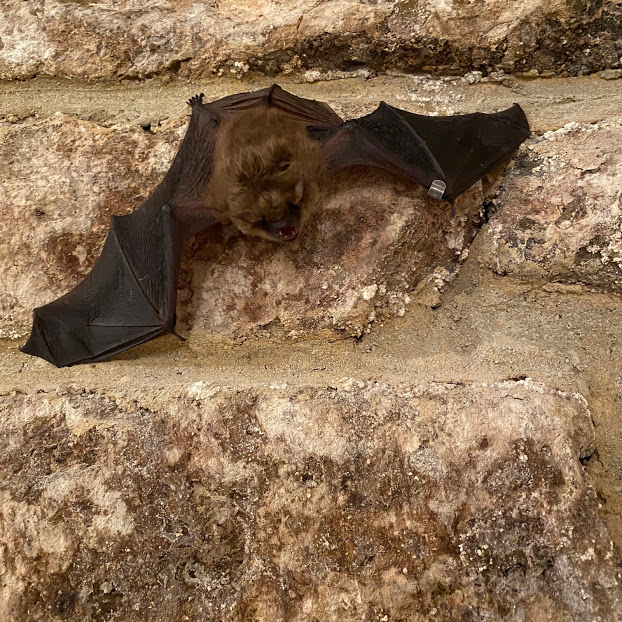
Below the building, we’ve got about 5,000 square feet of caverns with vaulted ceilings. They were were constructed in 1850 and used during the next 111 years when the building was a fully functional and operating brewery. Back then, there was no pasteurization and the beer had to be kept cold at all times. The caverns were built and used to age and store the beer at a cold temperature. The caverns run from about 35º in the winter to 50º in the summertime. In colder winters, they’ll get a tad colder but they never fully freeze.
They’re now partly our downstairs welding studio and wholly what our bats call home sweet home.
The bat caves if you will (and we will)

The DNR has been monitoring our caverns and studying the progression of White nose syndrome (WNS) in our bats, as well as bats all over the state and the country. WNS is a very serious problem affecting huge populations of bats. It’s killed millions of bats in North America. At some sites, 90 to 100 percent of bats have died.
WNS is a disease that affects hibernating bats. It’s caused by a specific fungus that grows in dark/damp places, like caves. The fungus gets on bats while they’re hibernating and causes changes that make them become active more than usual and burn up fat they need to survive the winter. Affected bats may do strange things like fly outside in the daytime in the winter.
There is no cure for white-nose syndrome, but scientists from all over the world are working together to study the disease, how it spreads and infects bats and what we can do to control it.
They’ve been monitoring the bats in our caverns for about 10 years. We they first started coming, we had four different species of bats. Big browns, little browns, northern long-eared bats, and eastern pipistrelles (the smallest species in Wisconsin, also known as tricolored bats).
We’re now down to just one, the big browns. Little brown bats, northern long-eared bats, and eastern pipistrelles are being found with higher fungal loads than other species such as big brown bats.
*Fun Fact! The DNR first found about our caves because of a friend I made in high school while working as a tour guide at Cave of the Mounds for a few years. She and I were cave buddies. When we both moved on from that job, she went to school and became a Conservation Biologist and a Cave/Mine Specialist (so cool, right?!). Years later, she remembered me telling her about the bats below the brewery and got in contact with us. And so began our relationship with the DNR monitoring our bats.

Since our relationship began, the DNR has been visiting and monitoring the bats at least once a year. Normally they don’t monitor private residences, most of their work is done in wild caves. Our location is unique in the fact that there are actually indoor caverns to begin with and they just happen to have the right conditions for bats to live.
Luckily they were able to visit in late February 2020 right before the Covid lockdowns began. And again, luckily, with the vaccines rolling out, they were able to safely visit a few weeks ago to check up on our little flying friends.
We opened up the doors and left ladders downstairs for them to use. Unfortunately we didn’t get to watch them inspect the bats up close as we usually do, but following safety measures we did snap a photo of them outside in the parking lot.
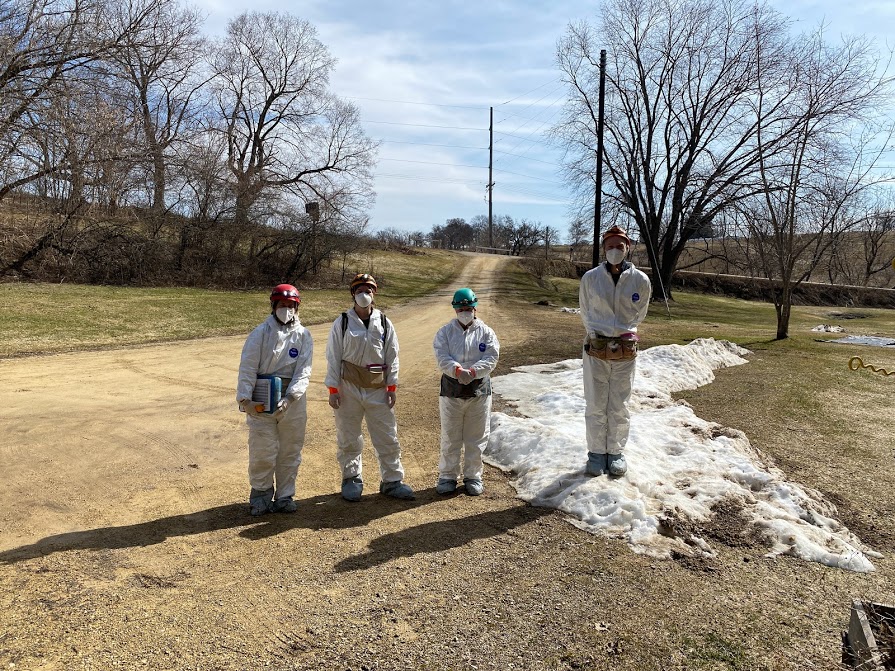
Below are a few photos from their previous visit in late February 2020, just before the Covid lockdown began last year:
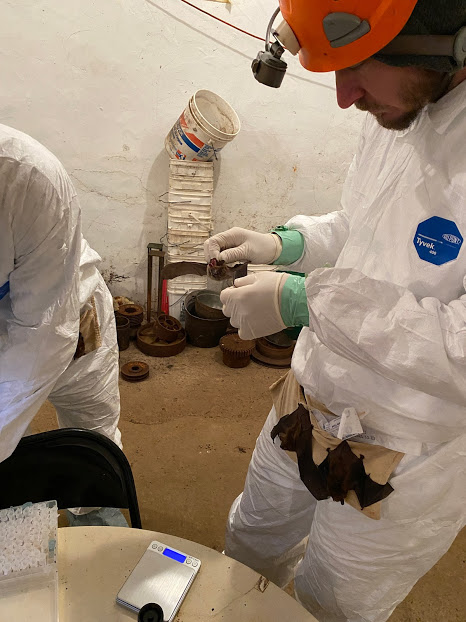
I just love the look on his face in the photo above. It’s so gentle. All the bat scientists just adore the bats and it really shows. It’s so fun and interesting to watch them collect the data and talk to each other about the findings (and talking to the bats while doing so). As they transcribe the details pertaining to WNS, they also note things like the size of the bat, its age, how many teeth it has, and the wing span. The reports are so organized and detailed.
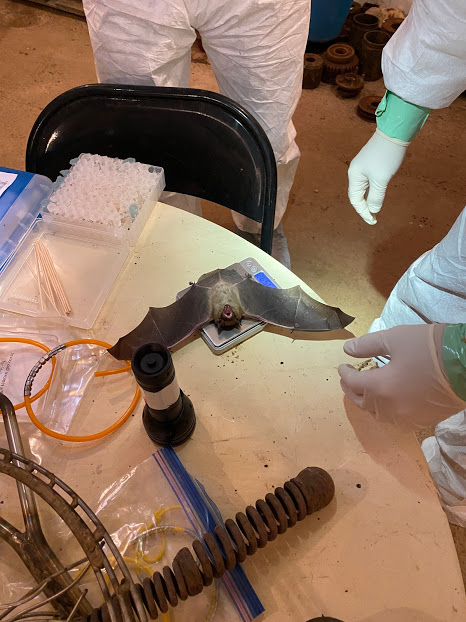
The scientists usually come in February. During that time of the year the bats are kind of “out of it”. They’ve been hibernating for a few months by this point and they aren’t quite ready to perk back up for the spring. They’re pretty docile and able to be gently examined without flapping around much.
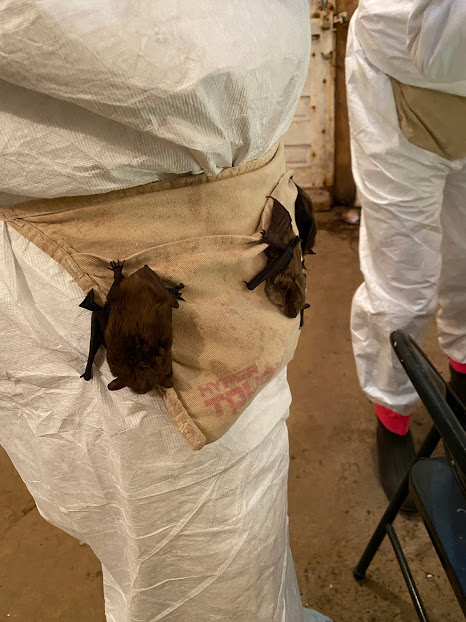
Usually, while working in pairs, one scientist collects the bats and sets them on the belt bag where they just hang out. One by one they are taken off and each one is examined. Once he/she has had its exam the other scientist picks it up and hangs it from their belt bag. This way they stay organized and know which bat is which.
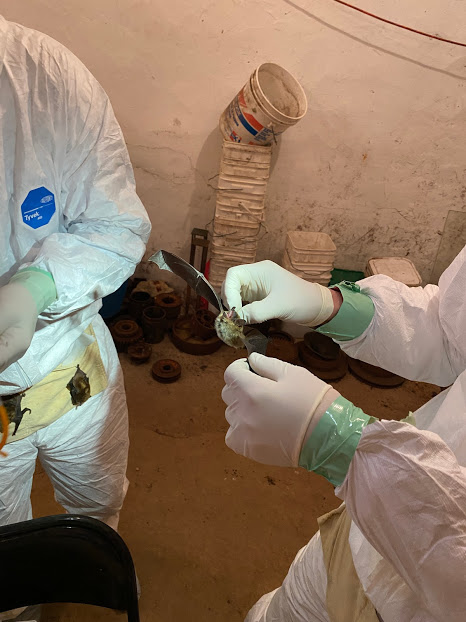
The bat in the photo above is a prime example of how kind of “out of it” the bats are. This one is just holding still, keeping it’s wings extended while the scientist holds it by its back to do the “hand off” to his coworker.
Below, the bats are returned back to their home on the side wall of the first cavern. We loving call that particular cavern the Vampire Room.
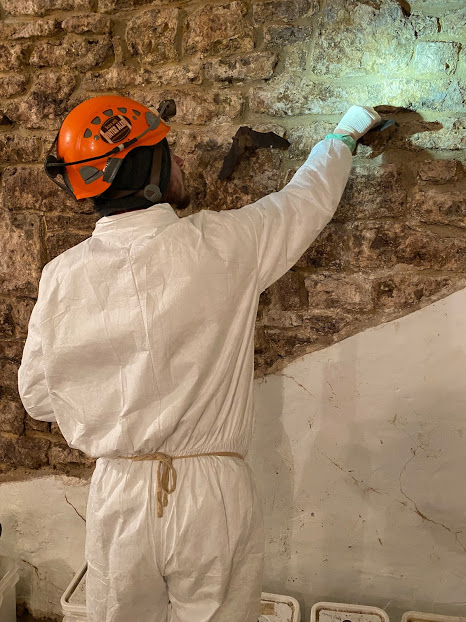
*Fun fact! We call this room the Vampire Room NOT because of the bats as you might have guessed. We once let the Mineral Point House of Dummies host their annual haunted house in this space. They set up this room as a vampire cemetery. There was a coffin in the middle of the room where a vampire would jump out to scare you. Sometimes the vampire made patrons (joyous and scared alike) crawl inside the coffin and would proceed to bang on the lid while they were inside. It was amazing. Anyone remember coming to the haunted house that year? Halloween of 1997.
You’ll see below, several photos from that memorable October that birthed the “Vampire Room”:
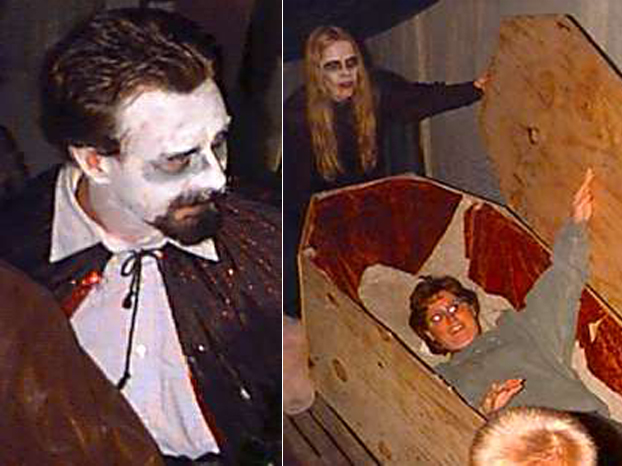
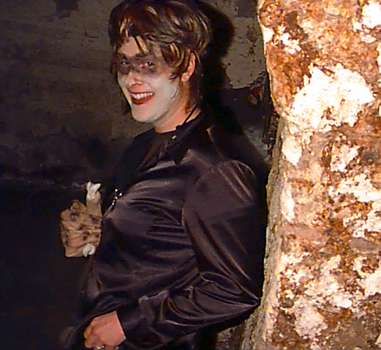
In the photo above, this haunted house “haunter” is standing in the same cavern as the cavern highlighted in the very first photo of this post (the one that shows the scientist looking up at the ceiling with his helmet flashlight). If you were standing in the doorway looking down into the room, this “haunter” is standing just a little to the left of where the first photo ends, in the doorway leading to a lower cavern that runs parallel to the Vampire room. Confusing and wordy much? I know. It’s like a maze.
Because I can’t be anyone other than me, here’s a crude diagram of what I’m trying to explain:

And also, again, because I can’t be anyone other than me and I can’t NOT share this link. There are more photos linked here from the House of Dummies Haunted House in our basement. I’m absolutely in awe and so thankful that website is still operational 24 years after the fact! Siriusly impressed (pun intended. If you know you know!)
Hope you enjoyed today’s ride. It was truly all over the place.
On a last note: Bats are friends! If you happen to have bats somewhere on your property or know someone that does, please consider reaching out to an expert to ask questions. White nose syndrome is truly horrific for bats and bats are SO important to our ecosystem.
Until next time, just know– I’m batty for you,
Claire

I loved this!
Thanks, Jocelyn!
This is so interesting! Thank you for your tolerance for bats. My house (an old Victorian ) has a turret where bats live. My husband wanted to block them from getting in but I convinced him to let them be. One of my favorite things to do on summer evenings is watch them flying out as the sun goes down. I counted over 60 last year 🙂
Wow, 60! So cool. Glad you’re enjoying your bats too!
Thanks so very much, Claire, for posting all three wonderful stories. Although I’ve been privileged to see many of the nooks and crannies, your photos and the narrative made this visit to the Brewery fascinating. Best, Frank & Sandee
Thanks so much! 🙂
I heard the bat story from Diana a couple years ago and enjoyed reading about it again. So interesting and amazing!
We love our bats! Thanks for following along, Diane!